Rectified tobacco undergoes a refining process to remove impurities, resulting in a smoother and more consistent flavor compared to non-rectified tobacco. Your choice depends on whether you prefer the pure, unaltered taste of non-rectified tobacco or the cleaner, milder experience offered by rectified varieties.
Table of Comparison
| Feature | Rectified Tobacco | Non-Rectified Tobacco |
|---|---|---|
| Definition | Processed tobacco with added substances for enhanced flavor and burn quality | Natural tobacco without chemical additives or enhancements |
| Processing | Undergoes chemical treatment and flavor adjustment | Minimal processing, mainly curing and drying |
| Flavor Profile | Consistent, enhanced taste due to additives | Natural, variable taste based on tobacco origin |
| Nicotine Content | Standardized and controlled levels | Variable, depending on tobacco leaf |
| Burn Quality | Optimized for even, controlled burn | Less consistent burn performance |
| Health Impact | Contains additives which may increase harm | Pure tobacco, but still harmful due to nicotine and tar |
| Usage | Preferred in manufactured cigarettes and commercial blends | Used in traditional tobacco products and hand-rolled cigarettes |
What Is Rectified Tobacco?
Rectified tobacco refers to tobacco that has undergone a chemical cleaning process to remove impurities, such as tar and unwanted nicotine, enhancing flavor purity and smoothness. Unlike non-rectified tobacco, which retains natural residues and harsher compounds, rectified tobacco provides a cleaner smoking experience with reduced harshness and improved consistency. This process is crucial for premium tobacco products aiming for refined taste and reduced health impact.
Understanding Non-Rectified Tobacco
Non-rectified tobacco retains its original chemical composition and natural nicotine levels, providing a more authentic and unaltered smoking experience compared to rectified tobacco. It undergoes minimal processing, preserving essential oils and tar components that contribute to its distinctive flavor profile and strength. Understanding non-rectified tobacco is crucial for appreciating traditional tobacco qualities and regulatory implications related to additive restrictions.
Key Differences Between Rectified and Non-Rectified Tobacco
Rectified tobacco undergoes a refining process that removes impurities, tar, and excess nicotine, resulting in a cleaner, smoother smoking experience compared to non-rectified tobacco, which remains in its natural, unprocessed state. Non-rectified tobacco retains more of its original oils and flavors, offering a richer taste but with higher harshness and potential health risks due to residual contaminants. Your choice between rectified and non-rectified tobacco impacts flavor intensity, smoothness, and chemical content, directly influencing overall smoking quality and health considerations.
Processing Methods: How Tobacco Is Rectified
Rectified tobacco undergoes a specialized processing method involving the removal of impurities and undesirable components through controlled heating and filtration, enhancing flavor consistency and reducing harshness. This process includes the use of chemical treatments and steam distillation to refine the tobacco leaf, unlike non-rectified tobacco which is typically dried and cured without such modifications. The result is a smoother, more uniform product favored in premium tobacco blends.
Chemical Composition: Comparing Rectified vs Non-Rectified
Rectified tobacco undergoes a refining process that selectively removes impurities and unwanted chemicals, resulting in a more standardized chemical composition with reduced levels of tar and nicotine derivatives. Non-rectified tobacco contains a broader spectrum of natural compounds, including higher concentrations of polycyclic aromatic hydrocarbons, alkaloids, and residual pesticides. This chemical distinction influences not only flavor profiles but also the health impact and combustion characteristics of each tobacco type.
Health Implications and Safety Concerns
Rectified tobacco undergoes a purification process that removes impurities and harmful substances, potentially reducing exposure to toxins compared to non-rectified tobacco. Non-rectified tobacco retains higher levels of carcinogens and nicotine, increasing the risk of respiratory diseases, cancer, and cardiovascular problems. Despite rectification, any tobacco product poses significant health risks due to the presence of addictive and harmful chemicals.
Flavor and Aroma: Sensory Differences
Rectified tobacco undergoes a refining process that removes impurities and harsh compounds, resulting in a smoother, cleaner flavor profile with reduced bitterness. Non-rectified tobacco retains more natural oils and residues, contributing to a stronger, more robust aroma and a fuller, often harsher taste. Sensory differences highlight rectified tobacco's subtle, mellow notes compared to the intense, earthy flavors and richer aroma found in non-rectified varieties.
Regulatory Standards for Rectified and Non-Rectified Tobacco
Regulatory standards for rectified tobacco require strict adherence to processes that remove impurities and harmful substances, ensuring a higher purity level compared to non-rectified tobacco. Non-rectified tobacco is subject to broader regulatory guidelines focusing on basic safety and labeling but lacks the stringent purification criteria imposed on rectified products. Compliance with standards such as those set by the FDA or EU Tobacco Products Directive is mandatory for rectified tobacco to guarantee reduced toxin content and enhanced consumer safety.
Market Trends and Consumer Preferences
Rectified tobacco, processed to reduce bitterness and impurities, is gaining traction in premium and health-conscious markets due to its smoother flavor and perceived quality advantages. Non-rectified tobacco remains popular in traditional and value-seeking segments where authenticity and natural taste are prioritized. Market trends indicate a growing consumer shift toward rectified tobacco, driven by increasing demand for refined smoking experiences and regulatory pressures that favor cleaner tobacco products.
Choosing the Right Tobacco: Factors to Consider
Rectified tobacco undergoes a refining process that removes impurities and smooths flavor, offering a cleaner smoking experience compared to non-rectified tobacco, which retains its natural oils and stronger, more robust taste. When choosing the right tobacco, consider your preference for flavor intensity, smoothness, and chemical additives, as rectified tobacco suits those seeking milder smoke and reduced harshness. Your choice impacts nicotine delivery and combustion behavior, making understanding these factors essential for a satisfying tobacco experience.
Rectified tobacco vs non-rectified Infographic

 libmatt.com
libmatt.com